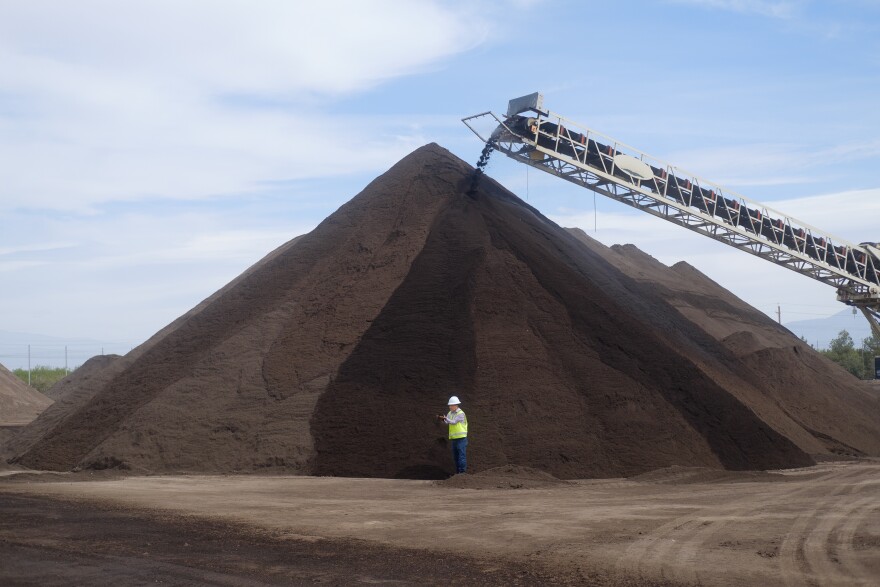On a warm spring afternoon, Ida Williams heated up water for tea at her home in Leimert Park in South L.A. The sun streamed through the kitchen window as she picked up a plastic receptacle with a green lid and placed it beside her chopping block on the counter.
“So, as I'm chopping my vegetables and things, I just leave this right here … and I can just take it and scoop it out right here,” said Williams, opening the kitchen pail and holding it at the counter's edge. There are banana peels, tomato trimmings and other food scraps inside. “It's very convenient for me because usually I'm trying to get it down the garbage disposal.”

Williams’ home is one of the 18,000 single-family households in L.A.’s pilot program for curbside food scrap collection. By summer, the city plans to expand the program to 40,000 households. By the start of next year, the city aims to have 750,000 L.A. households putting their food scraps in green bins used for leaves and lawn trimmings instead of the trash, so they can be composted instead of sent to a landfill.

(Tip: Before you start tossing food in your own green bin, check your city’s website to make sure the program has started in your area. And if you’re a renter, your landlord is required by law to enroll in the program.)
California became the second state in the nation after Vermont to make large-scale composting required by law when SB 1383 was passed in 2016. The law went into effect this January and requires all cities and counties to divert food and other organic waste from landfills. The goal is to reduce the amount of organic waste such as food in landfills by 75% by 2025.
Food waste makes up nearly 20% of the stuff in our landfills. When that food decomposes, it releases methane — tens of times more potent than carbon dioxide, it's one of the main greenhouse gasses fueling the climate crisis. That’s why landfills are California’s third largest source of methane emissions. Food waste in landfills across the U.S. has tripled since the 1960s.
Williams said being the “food scrap police” of her household is one way for her to do something good for the planet every day.
“I know there's plenty of people doing greater things than what I'm doing, and that's great,” Williams said. “But I'm here in my home. And I can do small things here.”

Where Will L.A.’s Food Waste Go?
Instead of going to the landfill, Williams’ green bin of food scraps and yard waste will be taken to a transfer station in downtown L.A. There, it’ll be combined with other food scraps and put in an 18-wheeler truck that will haul it 100 miles away to a large-scale compost facility just south of Bakersfield.

That facility is called Recology Blossom Valley Organics. (As L.A.’s curbside program rolls out, the city will contract with more compost facilities, said James Roska, an environmental engineer with L.A. Sanitation and Environment, or LASAN. Some of the green waste will also be used to fertilize local parks or go to facilities that recycle it into biogas energy, according to LASAN).
Recology is a 500-acre open-air facility surrounded by farm fields. They use effluent water from the local utilities district to run the compost operation — it’s part of their zero waste philosophy. Right now, most of the green waste they compost comes from parks and yards in Los Angeles and Kern County, said Sharbel Eid, the facility’s general manager.
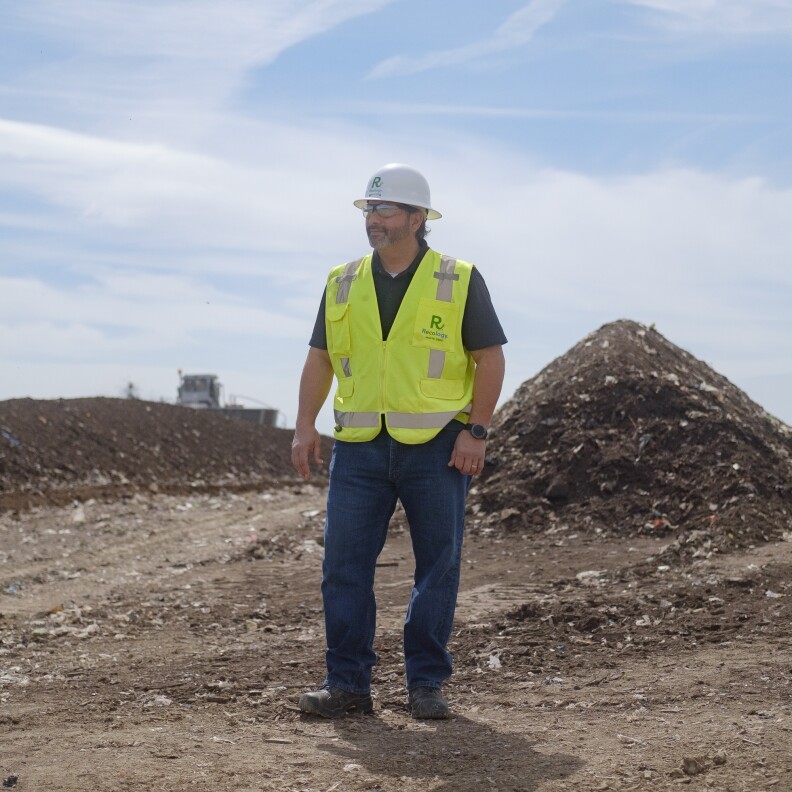
The employee-owned company has five composting facilities in California, said Robert Reed, media relations manager for Recology. This is one of the biggest. The other big one is up north in Vernalis, where the city of San Francisco sends its food scraps — it has had a mandatory curbside food scrap collection program since 2009. That program’s success proved to state leaders that mandatory composting made sense for everyone else, said Kevin Drew, a senior waste specialist with the San Francisco Department of the Environment.
On average, San Francisco diverts more than a million pounds of food waste from the landfill every day, said Alexa Kielty, the city's residential food scrap program coordinator.
San Francisco's success has been a result of refining large-scale composting techniques, Reed said. The company first partnered with San Francisco for a curbside food scrap collection pilot program in 1996 — the start of what would become the nation's first and largest urban food scraps composting collection program.
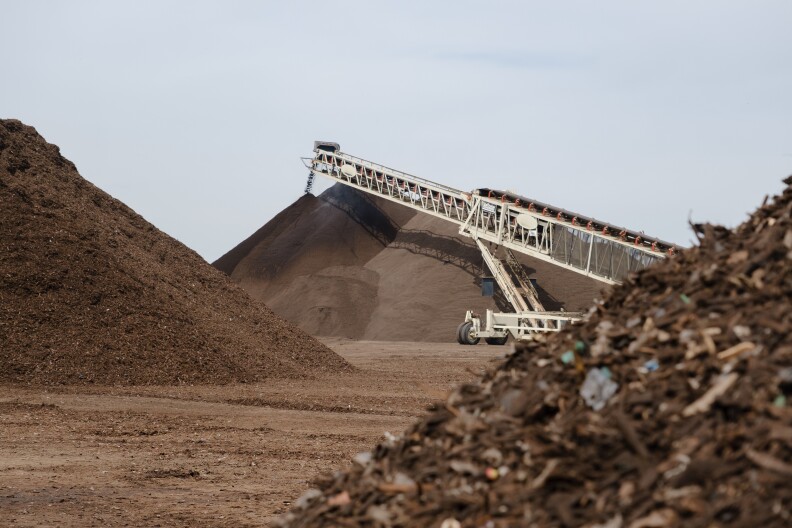
“This program gives individuals, communities and entire municipalities a way to do something very helpful to help slow down climate change,” Reed said. “And to help get carbon out of the atmosphere and back into the soil where it belongs.”
In 2002, San Francisco adopted the goal to divert 75% of its food waste by 2010 — it beat that goal two years early.
But San Francisco’s program couldn’t have worked without aggressive and multilingual public education campaigns about how to properly separate food scraps, as well as widespread distribution of kitchen pails, Kielty said.
“The real benefits for creating compost, it goes beyond the greenhouse gas reduction benefits,” Kielty said. “For the state of California, it's creating more drought-tolerant agriculture, replacing petroleum-based fertilizers with organic. We are seeing healthier, more nutritious food that's coming out of farms that are utilizing compost.”
How Does Large-Scale Composting Work?
At Recology, Eid walked me through the compost yard. The first step is sorting: A worker picked out large pieces of trash from a pile of mostly wood chips and other yard trimmings. There's a beach ball, a container of Kool-Aid Jammers and lots of plastic bags and containers.
After it’s sorted, the organic waste is ground up into pieces less than six inches long.
“We want to capture as much contamination before we grind because once we grind it, now we've turned this big contamination into small little pieces and now it's much harder for us to get them out,” Eid said.
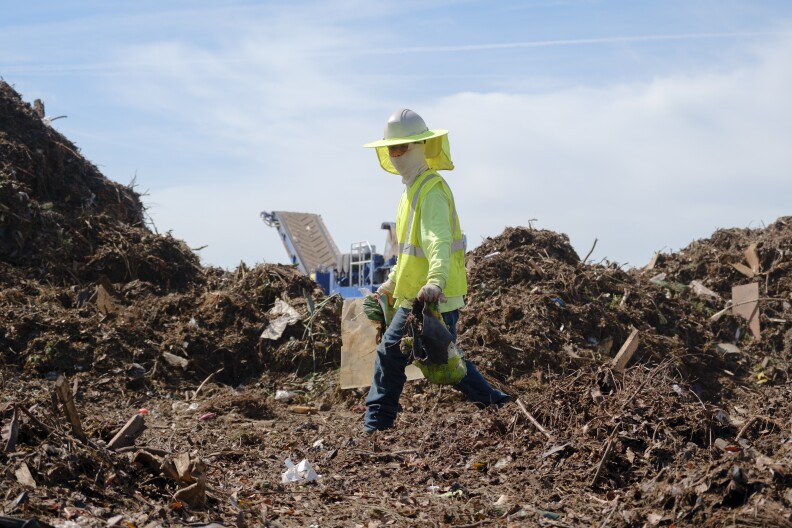
Plastic bags are the most common contaminant they get, Eid said. Tennis balls too, and they’ve even had lawn chairs and garden hoses thrown in the green bin. Eid said it’s important for people to keep things that can’t be composted out of the green bin — that’ll make better quality compost.
“The better at the bin that the customer is, the easier it becomes for us,” Eid said.
-
We're here to help get your outdoor space looking great with practical tips, news and what you need to do to keep conservation in mind.
After the green waste is sorted and ground up, it’s laid out into huge rows called windrows. Think of a farm field but the rows are higher than your head. This is where the composting magic happens.
A machine called a windrow turner idles at the edge of the row. It stands at least 10 feet high and more than a dozen feet wide. It has tracks like a tank and a spinning drum with blades in the center.
Then it straddles the windrow and slowly moves forward, churning the pile from the bottom up. White steam billows out of the pile — that amount of organic matter generates a lot of heat which helps microbes break it down.
“It’s very similar to how you would turn your compost at home,” Eid explained. “He's doing the same thing. He's aerating the pile.”
Backyard compost bins don’t have enough matter to generate the same amount of heat, which is why you can't add items such as meat and dairy when you're composting at home — a big distinction between backyard and commercial composting, said Roska.
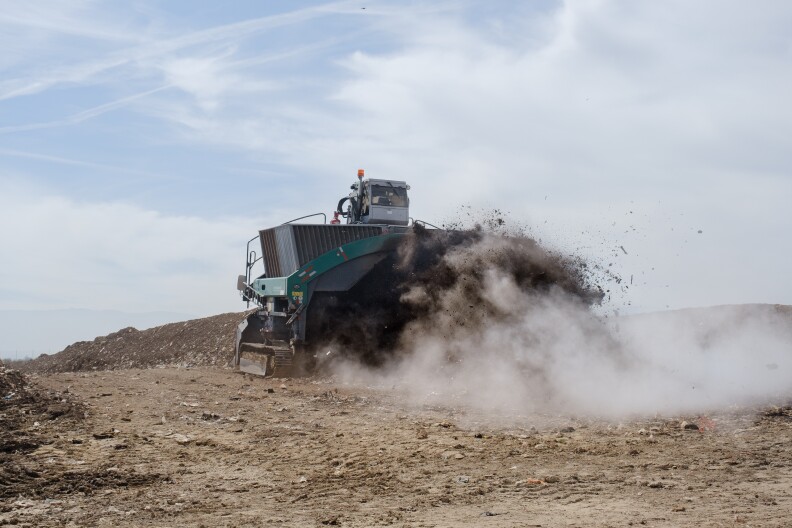
Why Does Composting Lower Methane Emissions?
The piles of garbage at landfills have almost no oxygen. Methane, or CH4, is made out of one carbon and four hydrogen atoms, so it thrives without oxygen. When you compost correctly and allow oxygen into the environment, much less methane is produced when microbes break down the organic matter.

After turning the windrows for 90 to 120 days, a sample of the compost is then sent to a soil lab to be tested for diseases such as salmonella. Then the compost goes through a final screen, kind of like an elaborate version of a mesh strainer, to get any further contaminants out.
We walk over to the huge pile of finished compost. It looks like rich soil and is damp and warm to the touch.
“Even now, I'm still amazed at how this whole thing goes from that to this,” Eid said, pointing towards the piles of green waste where we started and then to the towering pile of new compost.
And you might think the place would be pretty smelly. But the compost smells good — earthy.
Agustin Ortiz is the organics manager here. Eid calls him the mad scientist of composting. Ortiz said keeping out the smell and making good compost is all about the timing.
“Each windrow that I process, I put the same effort, the same emphasis, the same passion,” Ortiz said. “And the end result is going to reflect something like this good, rich nutrient soil, which is the compost.”

Where Does All That Compost End Up?
The journey doesn’t end here. Recology sells custom blends of compost with other soil additives to brokers, who sell it to farmers mostly in the San Joaquin Valley. They sell out of about 300,000 pounds of compost every year, Eid said.
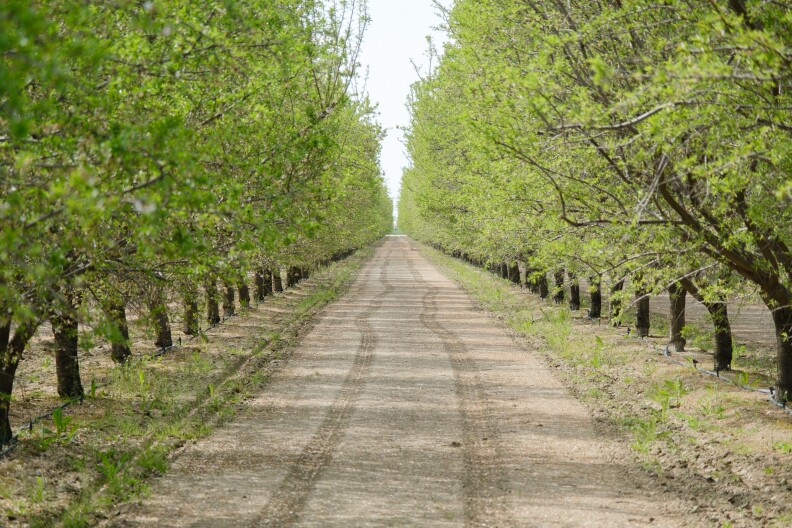
At a nearby almond orchard, I met agronomist and compost broker Ed Davis. He’s 70-years-young, raised in Bakersfield and a long-time farmer. He said using compost blends instead of chemical fertilizer makes for healthier soil, which needs less water and grows healthier food. And compost is actually cheaper than commercial fertilizer right now.
The biggest challenge, Davis said, is getting farmers to make the switch.
“Everybody just needs to realize that composters aren't a bunch of radical hippies,” Davis said. “It's really an incredibly important tool to improve production capacity, do it for a very economical price, while improving — dramatically improving — the quality of the soil.”
-
It's gonna be Yankees v the Boys in Blue
-
What candidates can — and can't — say they do
-
Nonprofit's launching fundraiser to keep it afloat
Compost is rich in nutrients and carbon, which plants need to grow. When farmers use compost, it drastically reduces the need for synthetic fertilizers, said Davis. Those fertilizers can pollute local water supplies and hurt wildlife, but compost actually helps build the health of the soil—it feeds rather than depletes the billions of micoorganisms that make soil good for growing. It also acts as a natural sponge, so farmers can use less water for crops, Davis said.
As cities roll out their composting programs, Davis believes compost blends can become a real competitor of chemical fertilizers.
“It is not new science,” Davis said. “Everybody moved away from what grandpa knew worked and went to this commercial fertilizer thing. It's basically getting back to the basics of soil science and agriculture.”

Costs and Benefits
Compost facilities require a lot of space, so building the infrastructure that cities need will be a challenge. Furthermore, progress could be hindered because there’s no funding attached to the law to help cities achieve compliance. The process of composting is more expensive than just tossing food in a landfill — these are reasons why your trash bill will likely go up by a few dollars.
And not all compost is created equal — while contamination is a challenge for all composters, composting at such a large scale and collecting food scraps from a public that doesn’t fully understand how to separate their food scraps can degrade the quality. Davis said pretty much all the compost he sells is mixed with smaller amounts of commercial fertilizer or other additives (It’s common for him to mix as much as 400 pounds of commercial fertilizer with upwards of 16,000 pounds of compost, he said). That’s why it’s so important for customers to properly separate their scraps, said Eid — it’ll make a better quality product for the farmer.

Some environmentalists have also argued that trucking compost a long way away adds to the carbon footprint of the process. A UC Merced study found that the benefit of reducing landfill methane emissions by composting food waste dwarfs the impact of trucking emissions. And with no permitted compost facilities in L.A., the city has little choice but to truck it to Recology, said Roska.
Compost facilities can also emit a lot of methane if they’re not managed properly, so it’s important that there’s strong oversight as the industry grows.
But there’s broad consensus that the benefits outweigh the costs. And keeping food waste out of landfills, whether it’s at the large scale or in your backyard, is a big win, said Michael Martinez, executive director of the community program L.A. Compost.
“All solutions are needed,” Martinez said. “It’s putting compost on the map and on the forefront of people's minds, of recognizing its importance as well as the negative impacts that just disposing of this organic material has on our environment when it's just left to rot in landfills."
“At the end of the day,” Martinez continued, “the very act of composting is collectively powerful across all scales.”

